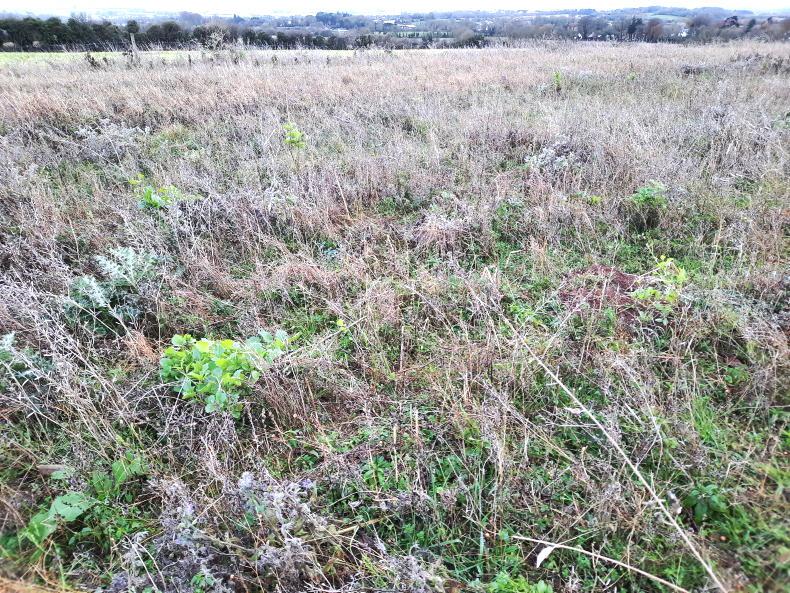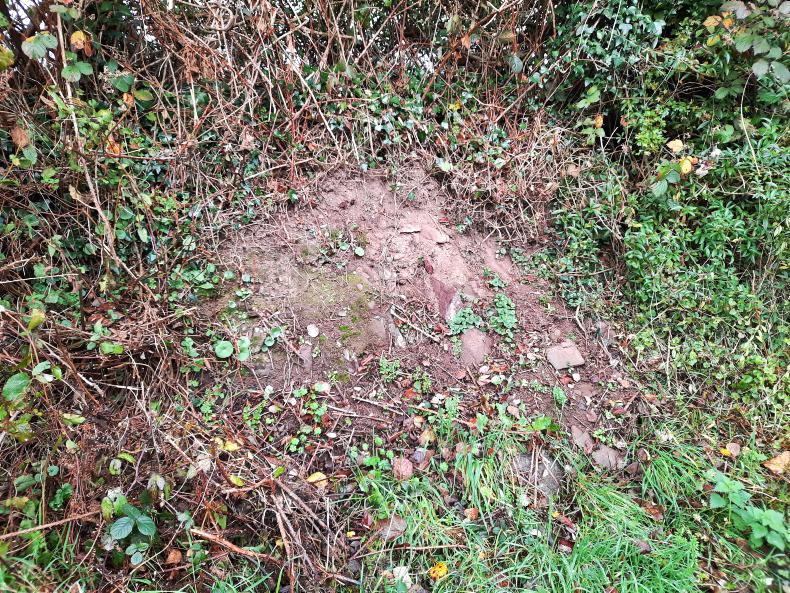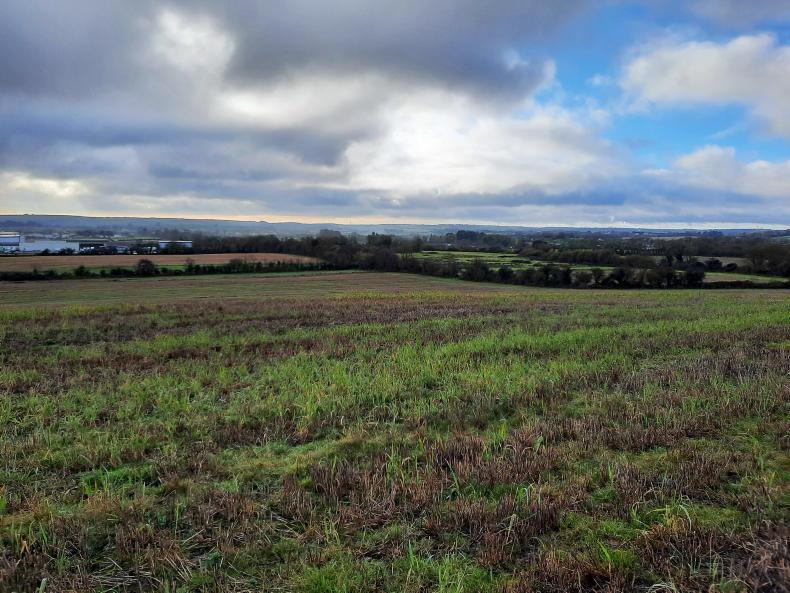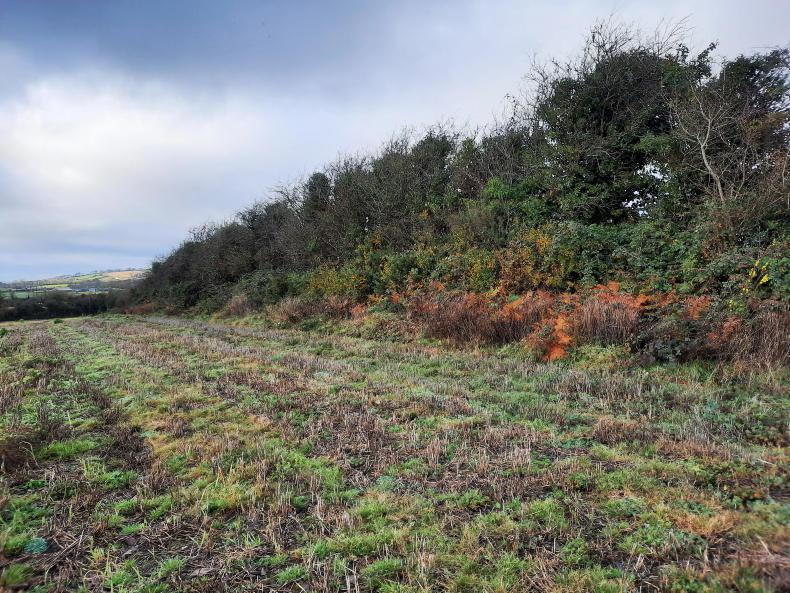We all need to eat and we all need to play our part in the biodiversity crisis. Paul Moore farms just outside Midleton in Co Cork and he is a firm believer that whatever the farming system, food production with good-quality habitats can work hand in hand to increase biodiversity on Irish farms.
Farming tillage and beef, he is a conventional, full-time farmer practising regenerative agriculture on an outside block, who needs to bring home a living from the farm. Interestingly, he has been a member of BirdWatch Ireland for over 30 years.
From a young age, Paul has watched the wildlife on his farm and tried to provide food and nesting areas. As we walk around the farm, we see hundreds of birds of different types, which Paul identifies from a far.

Wild bird cover on Paul's farm.
The farm looks fairly typical of many farms. The cattle were in but will soon be going out to graze cover crops.
There’s winter stubble and different types of hedgerows. This is important.
There is an odd overgrown hedge. Some of the hedges are allowed to grow and are trimmed every few years, while many are escaped and form a row of trees.
Paul notes that some of these probably need to be managed soon to rejuvenate them, but that a mix of hedgerows is very important.
There is also plenty of dead wood and elm trees around the farm. Dutch elm disease kills these trees when they hit a certain age and they do regenerate, but where it is safe to leave the dead trees Paul leaves them standing as the ivy which has grown up the trees provides feeding and shelter for birds and pollinators and the standing dead wood is a habitat for wood-burrowing insects.

Paul scraped back some of the greenery on the bank to leave bare soil which attracts bees.
Paul has started to leave margins around fields, simply moving the electric fence out a few metres or having an uncultivated wider margin to provide a path for birds and wildlife. He also has bird and bat boxes in different areas of the farm.
Benefits of over-winter stubble
Spring malting barley is the main tillage crop on the farm and as we climb to the top of a hill, steam can be seen coming from Midleton Distillery just a short distance away.
Some of Paul’s barley is eventually sold to the distillery to produce whiskey.
At the top of that hill, you are looking down on a stubble field. On that stubble, a flock of skylarks fly around. Their brown feathers turn to white as they rise up in synchronisation, circle and land again.
Paul says that you will only see skylarks landing in the overwinter stubble. They do not like cover crops as they are too dense, but yellow hammers, pipits and thrushes will feed in the cover crops.
Decline in birds linked to tillage
As the area of tillage land has declined in Ireland so have the birds associated with tillage and the habitats it provides.

Over-winter stubble is very important for a number of birds species.
Yellow hammer, stock dove, skylark, linnet, lapwing, the grey partridge and reed bunting are just some that have decreased in numbers.
Paul notes that if you see a map of yellow hammer distribution and a map of tillage land, the two are very similar. Yellow hammers can survive on intensive tillage land, but not on intensive grassland.

Some of the hedges have escaped. It is important to have a mix of hedge types on the farm.
Paul adds that he doesn’t see the skylarks in the grass field or he doesn’t see the snipe which live on a wetland on the farm in the overwinter stubble. They need their most appropriate habitat.
The next question that might be coming to readers’ minds may be about nitrates and green cover.
Nitrates rules are calling for green cover on bare fields over winter and for a host of good reasons.
Not only does green cover soak up nutrients which may otherwise be lost to water it also protects soil from erosion and can help to improve soil structure.
However, if all tillage land is tilled to regenerate volunteers and weeds or planted with winter crops or cover crops, what will happen to these tillage-specific birds that need stubble to survive? Their numbers may continue to decline.
Paul says he is not aware of any research into the effect of reducing the amount of overwinter stubble cover on these bird populations. It should be noted that the headlands of these stubble fields have plenty of volunteer barley and there are weeds scattered across the stubble, but it is not covered in green.
The open stubble allows birds to easily see seeds which they eat, while they also look for insects, some of which are on the weeds and volunteers. It is the clear line of sight and travel which is important.

An owl box on Paul Moore's farm.
Over the hill, hundreds of linnets rise from the wild bird cover. Paul plants wild bird cover under GLAS.
This year, it contains barley, oats, linseed and radish, as well as some flowers for pollinators.
He has put some perches into the cover using fencing posts as birds like to keep watch and drop down on their prey.
He laughs and adds that these perches act as an integrated pest management tool for rodents.
Responsibility needs to fall back to consumer too
Throughout the conversation, Paul keeps coming back to the consumer and how farmers need help if there’s to be a reversal in the decline in farmland biodiversity.
Consumers could be better informed
He comments that there are many stakeholders in food production systems and farmers, industry and consumers all have a role to play. Consumers could be better informed to help them make more informed choices or even be willing to pay more for that food and farmers need to embrace that there needs to be changes if declines are to be reversed.
If you choose to buy cheap food and you’re not asking yourself what system that food was produced under, then you’re as responsible as anyone.
In Ireland, farmers follow a lot of rules when it comes to habitats and hedgerows and aside from the actions they take on an individual level, such as farmers like Paul, they participate in schemes which could improve habitats as part of CAP and European Innovation projects.
In Ireland, farmers follow a lot of rules when it comes to habitats and hedgerows and aside from the actions they take on an individual level, like farmers like Paul, they participate in a lot of schemes which improve habitats as part of CAP and European innovation projects.
No doubt there is plenty of work to be done on farms, but financial incentives could help to improve biodiversity on farms.
In some countries, there is a label on produce which states that it is produced in harmony with nature. Farmers are then paid a premium for these goods
Paul is a member of BirdWatch Ireland and noted that, up to fairly recently, it might have been seen as somewhat odd for a farmer to be a volunteer with an environmental organisation but times are changing.
Having everyone working together and farmers explaining the work they do to the general public is exactly what’s needed.
“There have been massive losses in biodiversity, but everybody needs to think harder and ask ‘why does that happen?’ Everyone is a stakeholder in this,” he says.
A mix of habitats is essential – not all birds like trees
Biodiversity needs diversity. Whether that be catch crops or winter stubble or trees or hedgerows, farmers can make plenty of space for wildlife on their farms.
Field margins are left wide in some parts of Paul’s farm and they make a valuable contribution to his IPM strategy as they can provide predators for pests.
“There’s a mentality that you have to farm every acre, but you don’t. Moving the fence out goes against all your instincts as a farmer, I suppose, but that’s a habitat created.” Pointing at the field margin, Paul says: “I’ve seen barn owls hunting along that. There’s bats up there every night because of all the insects. During the summer, it’s a riot of wildflowers.”

Paul has left some margins around fields. these margins are full of flowers for pollinators in the summer and provide a path for wildlife to travel in.
Paul says that small changes can have a big impact. He pointed to a patch in the ditch he had scraped clear with the bucket of the loader to leave bare soil for bees.
If all farmers did a small bit and did it right it would help with an awful lot of the problems we have
He has been planting oak trees into his hedgerows to compensate for the loss of Ash and Elm.“To have wildlife on your farm you don’t need to be managing acres. You can start small.
“If all farmers did a small bit and did it right it would help with an awful lot of the problems we have. You don’t have to re-wild the whole farm. This is a farm, not a nature reserve.”
Paul explains that habitats need a certain amount of management and made a point of saying one habitat does not suit everything. For example, many bird species do not like trees. Lapwings are ground-nesting birds and do not want a tree within 500m of their nest. When it comes to habitats, variety is definitely a key thing to remember.
What can you do on your farm to improve habitats?
Allow hedges to grow for a few years without trimming.Allow trees to grow up every few hundred metres in some hedgerows.Allow some hedges to escape.Leave or create a wetland area on the farm.Place bird boxes in some trees.Place an owl box in a tree or at the end of an old farm building with a clear line of sight to the box.Leave some over winter stubble.Plant wild bird cover containing a cereal crop.Leave a margin around fields to provide a path for wildlife.
We all need to eat and we all need to play our part in the biodiversity crisis. Paul Moore farms just outside Midleton in Co Cork and he is a firm believer that whatever the farming system, food production with good-quality habitats can work hand in hand to increase biodiversity on Irish farms.
Farming tillage and beef, he is a conventional, full-time farmer practising regenerative agriculture on an outside block, who needs to bring home a living from the farm. Interestingly, he has been a member of BirdWatch Ireland for over 30 years.
From a young age, Paul has watched the wildlife on his farm and tried to provide food and nesting areas. As we walk around the farm, we see hundreds of birds of different types, which Paul identifies from a far.

Wild bird cover on Paul's farm.
The farm looks fairly typical of many farms. The cattle were in but will soon be going out to graze cover crops.
There’s winter stubble and different types of hedgerows. This is important.
There is an odd overgrown hedge. Some of the hedges are allowed to grow and are trimmed every few years, while many are escaped and form a row of trees.
Paul notes that some of these probably need to be managed soon to rejuvenate them, but that a mix of hedgerows is very important.
There is also plenty of dead wood and elm trees around the farm. Dutch elm disease kills these trees when they hit a certain age and they do regenerate, but where it is safe to leave the dead trees Paul leaves them standing as the ivy which has grown up the trees provides feeding and shelter for birds and pollinators and the standing dead wood is a habitat for wood-burrowing insects.

Paul scraped back some of the greenery on the bank to leave bare soil which attracts bees.
Paul has started to leave margins around fields, simply moving the electric fence out a few metres or having an uncultivated wider margin to provide a path for birds and wildlife. He also has bird and bat boxes in different areas of the farm.
Benefits of over-winter stubble
Spring malting barley is the main tillage crop on the farm and as we climb to the top of a hill, steam can be seen coming from Midleton Distillery just a short distance away.
Some of Paul’s barley is eventually sold to the distillery to produce whiskey.
At the top of that hill, you are looking down on a stubble field. On that stubble, a flock of skylarks fly around. Their brown feathers turn to white as they rise up in synchronisation, circle and land again.
Paul says that you will only see skylarks landing in the overwinter stubble. They do not like cover crops as they are too dense, but yellow hammers, pipits and thrushes will feed in the cover crops.
Decline in birds linked to tillage
As the area of tillage land has declined in Ireland so have the birds associated with tillage and the habitats it provides.

Over-winter stubble is very important for a number of birds species.
Yellow hammer, stock dove, skylark, linnet, lapwing, the grey partridge and reed bunting are just some that have decreased in numbers.
Paul notes that if you see a map of yellow hammer distribution and a map of tillage land, the two are very similar. Yellow hammers can survive on intensive tillage land, but not on intensive grassland.

Some of the hedges have escaped. It is important to have a mix of hedge types on the farm.
Paul adds that he doesn’t see the skylarks in the grass field or he doesn’t see the snipe which live on a wetland on the farm in the overwinter stubble. They need their most appropriate habitat.
The next question that might be coming to readers’ minds may be about nitrates and green cover.
Nitrates rules are calling for green cover on bare fields over winter and for a host of good reasons.
Not only does green cover soak up nutrients which may otherwise be lost to water it also protects soil from erosion and can help to improve soil structure.
However, if all tillage land is tilled to regenerate volunteers and weeds or planted with winter crops or cover crops, what will happen to these tillage-specific birds that need stubble to survive? Their numbers may continue to decline.
Paul says he is not aware of any research into the effect of reducing the amount of overwinter stubble cover on these bird populations. It should be noted that the headlands of these stubble fields have plenty of volunteer barley and there are weeds scattered across the stubble, but it is not covered in green.
The open stubble allows birds to easily see seeds which they eat, while they also look for insects, some of which are on the weeds and volunteers. It is the clear line of sight and travel which is important.

An owl box on Paul Moore's farm.
Over the hill, hundreds of linnets rise from the wild bird cover. Paul plants wild bird cover under GLAS.
This year, it contains barley, oats, linseed and radish, as well as some flowers for pollinators.
He has put some perches into the cover using fencing posts as birds like to keep watch and drop down on their prey.
He laughs and adds that these perches act as an integrated pest management tool for rodents.
Responsibility needs to fall back to consumer too
Throughout the conversation, Paul keeps coming back to the consumer and how farmers need help if there’s to be a reversal in the decline in farmland biodiversity.
Consumers could be better informed
He comments that there are many stakeholders in food production systems and farmers, industry and consumers all have a role to play. Consumers could be better informed to help them make more informed choices or even be willing to pay more for that food and farmers need to embrace that there needs to be changes if declines are to be reversed.
If you choose to buy cheap food and you’re not asking yourself what system that food was produced under, then you’re as responsible as anyone.
In Ireland, farmers follow a lot of rules when it comes to habitats and hedgerows and aside from the actions they take on an individual level, such as farmers like Paul, they participate in schemes which could improve habitats as part of CAP and European Innovation projects.
In Ireland, farmers follow a lot of rules when it comes to habitats and hedgerows and aside from the actions they take on an individual level, like farmers like Paul, they participate in a lot of schemes which improve habitats as part of CAP and European innovation projects.
No doubt there is plenty of work to be done on farms, but financial incentives could help to improve biodiversity on farms.
In some countries, there is a label on produce which states that it is produced in harmony with nature. Farmers are then paid a premium for these goods
Paul is a member of BirdWatch Ireland and noted that, up to fairly recently, it might have been seen as somewhat odd for a farmer to be a volunteer with an environmental organisation but times are changing.
Having everyone working together and farmers explaining the work they do to the general public is exactly what’s needed.
“There have been massive losses in biodiversity, but everybody needs to think harder and ask ‘why does that happen?’ Everyone is a stakeholder in this,” he says.
A mix of habitats is essential – not all birds like trees
Biodiversity needs diversity. Whether that be catch crops or winter stubble or trees or hedgerows, farmers can make plenty of space for wildlife on their farms.
Field margins are left wide in some parts of Paul’s farm and they make a valuable contribution to his IPM strategy as they can provide predators for pests.
“There’s a mentality that you have to farm every acre, but you don’t. Moving the fence out goes against all your instincts as a farmer, I suppose, but that’s a habitat created.” Pointing at the field margin, Paul says: “I’ve seen barn owls hunting along that. There’s bats up there every night because of all the insects. During the summer, it’s a riot of wildflowers.”

Paul has left some margins around fields. these margins are full of flowers for pollinators in the summer and provide a path for wildlife to travel in.
Paul says that small changes can have a big impact. He pointed to a patch in the ditch he had scraped clear with the bucket of the loader to leave bare soil for bees.
If all farmers did a small bit and did it right it would help with an awful lot of the problems we have
He has been planting oak trees into his hedgerows to compensate for the loss of Ash and Elm.“To have wildlife on your farm you don’t need to be managing acres. You can start small.
“If all farmers did a small bit and did it right it would help with an awful lot of the problems we have. You don’t have to re-wild the whole farm. This is a farm, not a nature reserve.”
Paul explains that habitats need a certain amount of management and made a point of saying one habitat does not suit everything. For example, many bird species do not like trees. Lapwings are ground-nesting birds and do not want a tree within 500m of their nest. When it comes to habitats, variety is definitely a key thing to remember.
What can you do on your farm to improve habitats?
Allow hedges to grow for a few years without trimming.Allow trees to grow up every few hundred metres in some hedgerows.Allow some hedges to escape.Leave or create a wetland area on the farm.Place bird boxes in some trees.Place an owl box in a tree or at the end of an old farm building with a clear line of sight to the box.Leave some over winter stubble.Plant wild bird cover containing a cereal crop.Leave a margin around fields to provide a path for wildlife. 











 This is a subscriber-only article
This is a subscriber-only article



















SHARING OPTIONS: